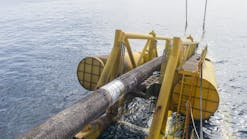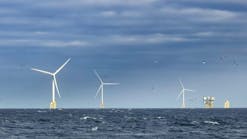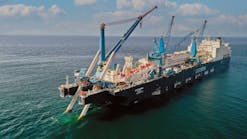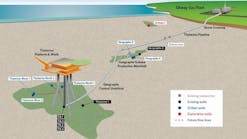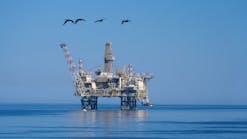Nick Terdre - Contributing Editor
GDF SUEZ is preparing to take over operatorship of the Gjøa field in the North Sea when it comes on stream in October. The project will be the making of the company in the Norwegian sector, according to GDF SUEZ E&P Norge managing director Terje Overvik.
“We have established a competent organization to run Gjøa,” he says. “Being the operator of the production phase is very important for us, not only because of the responsibility that is involved, but also because from a broader perspective it will help us to secure new business opportunities and to recruit new people.” Since Overvik arrived in 2007, the staff number has risen from 40 to around 180, to service both Gjøa’s needs and the company’s growing range of activities.
Taking on the production operator role will also set GDF SUEZ in a select international band operating similar-size projects in the Norwegian sector, including BP, ConocoPhillips, ExxonMobil, and Shell.
Statoil has operated Gjøa’s development phase. The agreement to split the operatorship – which occurred previously on the Ormen Lange project in the Norwegian Sea – predates Overvik’s arrival from Statoil. The two companies reached the agreement following Gaz de France’s acquisition in 2003 of Norsk Hydro’s 30% stake in the field. This was approved by Norway’s government in 2004.
Statoil has a 20% interest in the license, PL 153, and the remaining interests are held by Petoro (30%), which manages the state’s direct financial interest in offshore oil and gas, RWE Dea (8%), and Shell (12%).
Construction spread
Gjøa, discovered in 1989, is in blocks 35/9 and 36/7, around 60 km (37 mi) north of the giant Troll gas field and 50 km (31 mi) from the shore. It is an area previously devoid of production infrastructure, so the project will be providing facilities for nearby finds to be developed at a later stage.
The development is the largest industrial project currently under way in Norway, and one of the country’s largest ever, incurring investment of over NOK 30 billion ($4.7 billion) to tap the field’s 82 MMbbl of oil and condensate and 40 bcm of gas.
The reserves will be produced through a large semisubmersible production platform with a 14,200-metric ton (15,653-ton) hull and a 22,000-metric ton (24,251-ton) topside. Production capacity is 87,000 b/d of liquids and 17.3 MMcm/d of gas. The hull was built in South Korea by Samsung; the topsides at the Aker Stord yard in western Norway; and the 100-bed living quarters at the nearby Apply Leirvik yard.
Altogether 11 production wells are planned, seven for oil and four for gas. FMC Technologies has supplied the subsea equipment. Development drilling, which the Transocean semisubTransocean Searcher started in January 2009, is challenging as the oil is contained in thin layers of between 30 and 45 m (98-147 ft). Statoil is responsible for managing this activity.
Following mating of the hull and topsides early this year, a slight hiccup arose when classification society DNV decided that some minor strengthening was needed on parts of the hull. Following extra work at Aker Stord, the platform was towed out to the field in mid-June. Delays were kept to a minimum as commissioning work elsewhere on the platform was able to continue while it was in the yard, and start-up is still expected in early October, when GDF SUEZ takes the reins.
Statoil’s Vega fields, around 35 km (21.7 mi) to the west, are being developed as subsea tiebacks to the Gjøa platform, both due onstream also in October. The Vega licensees have contributed part of the Gjøa capex to cover their share of the platform facilities. Peak production from Vega and Vega South will be 25,000 b/d of condensate and 7 MMcm/d of gas; the Vega fields contain 26 MMbbl of condensate and 18 bcm of gas.
Liquids from Gjøa and Vega will be transported to Mongstad in western Norway through a new 60-km (37-mi), 15-in. (38-cm) pipeline linking into the Troll C to Mongstad line, while gas will be transported to the UK by a 130-km (80.8-mi), 28-in. (71-cm) pipeline which has been tied into the Flags trunkline in the UK sector. These lines were installed last year by Saipem’sCastoro 6 laybarge. As part of Norway’s gas export infrastructure, the gas pipeline came under the Gassled ownership structure in June, making GDF SUEZ one of the Gassled partners. It is now operated by Gassco.
One novel feature of the development is the hybrid power solution, whereby 40 MW will be imported from shore while gas turbines on the platform generate the balance of the power requirement. The intention is to reduce carbon dioxide emissions by up to 210,000 metric tons/yr (231,485 tons/yr).
Organizational issues
GDF SUEZ has been closely involved in the development of Gjøa since the outset, with personnel integrated into the project teams and participating in activities such as commissioning of the hull, construction of the living quarters, and manufacture of the subsea equipment.
In parallel, the company has been busy with operations preparations: hiring and training staff, developing procedures, and writing governing documents. To secure a smooth and controlled handover, this process is being organized in accordance with a strategy document which sets out four key milestones.
The different parts of the process have been divided between 12 working groups comprising Statoil and GDF SUEZ representatives, all of whom report to a coordinating team responsible for supervising the process and reporting in turn to top management. Checklists and protocols have been developed for each area. The first milestone was reached in September last year with the handover of the first sub-systems from commissioning to operations.
Maintenance will be managed by a computerized system in conjunction with a technical data library. These tools, which will be vital to maintaining the safety and integrity of all the equipment and systems on the platform, will interface with other management and accounting systems. Integration of the technical data library will make it possible for plant data to be instantly updated.
All main contracts for the production phase have been awarded. The operations and logistics base in Florø in western Norway will be run by Fjord Base, which in March opened a new $5.3-million office and storage building for the project. From the 1,500-sq km (579-sq mi) building, which has been leased by GDF SUEZ for 20 years, its staff will run procurement, material administration, field supply, helicopter transport and personnel coordination. A 4,000-sq m (1,544-sq mi) workshop is also under construction to serve maintenance of subsea equipment on the Gjøa and Vega fields.
Gjøa will be produced through 11 subsea wells.
Meling & Co will provide its new platform supply vesselSiddis Supplier under an eight-year contract with a three-year extension option. CHC Norway provides helicopter transport under a five-year contract with an additional three-year option, using a newbuild Sikorsky S92A. Gjøa is around 70 km (43 mi) from Florø.
GDF SUEZ has appointed IKM as its operations support contractor. Production and other platform activities will be run by integrated operations (IO) involving onshore teams working with the offshore organization -- the first time the company has implemented this method.
The latest work processes and tools available for IO will be used. Collaboration rooms with state-of-the-art equipment have been set up at the company’s headquarters in Stavanger, the platform living quarters, and the logistics base at Florø. Each morning, operations personnel at the three locations participate in a video conference to discuss the day’s program. A third collaboration room is under construction at the operations base and will be commissioned ahead of start-up.
Tie-in potential
Condition monitoring will be applied not only to rotating machinery but also key valves and static equipment and process systems. IT solutions have been selected that can access applications with data sources without hardwiring – these have the potential to extend condition monitoring to incorporate intelligent monitoring of complex process elements.
Production on Gjøa is expected to continue until around 2025, but if GDF SUEZ’s ambitions to develop the platform as a hub for third-party reserves in the area are realized, it will remain in operation much longer. The platform has a 30-year design life.
There are numerous undeveloped discoveries in the area. One is Astero in 35/11, in which the company has a 15% stake. Astero, with estimated reserves of 40 MMbbl of oil and 2.1 bcm of gas, is around 30 km (18.6 mi) southwest of Gjøa, but only 5 km (3.1 mi) from Vega South. Just to the east, in 35/12 is last year’s Grosbeak discovery, with reserves estimated at 35-190 MMboe. To the north of Gjøa, discoveries include Statoil’s Peon in 35/2, thought to contain 17.7 bcm, and Verbundnetz Gas’s Agat, another gas field.
Gro stakes
In just a few years GDF SUEZ has built a strong position in the Norwegian offshore sector, acquiring a diverse portfolio that includes licenses in both mature and frontier areas. It is a partner in three producing fields, Fram in the North Sea, Njord in the Norwegian Sea, and Snøhvit, along with the associated Melkøya LNG plant, in the Barents Sea, as well as in the Gudrun field in the North Sea, currently under development.
GDF SUEZ also participates in the most keenly awaited well in the Norwegian sector at present, Shell’s 6604/10-1 appraisal of last year’s Gro discovery in the Vøring basin in the Norwegian Sea. Gro’s reserves were estimated at 10-100 bcm (353-3,531 bcf) of gas following the discovery last year; although some observers think they could be much higher.
If this year’s appraisal confirms that the field is commercial, GDF SUEZ, Shell and fellow licensee Statoil will begin the challenging task of constructing a development plan for this deepwater – 1,350 m (4,429 ft) – field 350 km (217 mi) from land and far from infrastructure. The company has a 10% interest that it acquired from Shell just before the discovery well was spudded.
Elsewhere, the company operates producing fields onshore in Germany and offshore in Holland, where it is the largest offshore operator, and in the UK. But these are mainly small gas fields, many of them in decline, produced through small platforms. Gjøa takes it onto a new level as an operator. Already Norway is responsible for 20% of the group’s gas production, and in coming years this proportion is set to rise to 35%. It also accounts for 40% of the group’s reserves. “Norway is very important to our group,” says Overvik.
Offshore Articles Archives
View Oil and Gas Articles on PennEnergy.com



